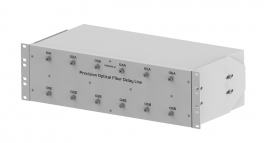

Femtosecond lasers have found home in many research labs and industries. They are used in sensing (for example for gas traces and combustion products monitoring), in medicine and biological research (for example multiphoton microscopy and imaging), in nonlinear and time-resolved spectroscopies (for example PAF, SHF, SFG, or CARS), in optical metrology (where frequency combs in particular are utilized), for terahertz generation and in countless quantum and nonlinear optics experiments.
The vast majority of the ultrafast systems are either erbium (Er) or ytterbium (Yb) based, meaning that they produce pulses (solitons) in the 1550 nm, or in 1045 nm spectral regions, respectively. Most often the fs lasers are not tunable, and even if they are, the tuning range is very limited.
Now all of this can change. With the use of very simple and cost-effective, plug&play modules from Fibrain, any femtosecond Er- or Yb- (or holmium or thulium, for that matter) based source can become a wavelength tunable source! The tuning is fully continuous and very broadband, even more than 500 nm. This way a 1045 nm soliton source can produce pulses at for example 1500 nm wavelength or a 1550 nm fiber laser becomes a 2000 nm source. There are no gaps in the tuning range, and suddenly the coveted (by biomedical scientists) 1350 nm and 1700 nm spectral windows become readily accessible.
The nonlinear modules are absolutely passive and plug&play, with the standard fiber optic connectors (for example FC APC or E2000 APC) at both ends. All that is required for tuning is changing the laser output power. The rest is done by the nonlinear module connected to the laser output. The higher the soliton peak power, the larger the spectral shift.
And from the average user perspective that’s all to know there. The more physically-minded may be interested to know that the spectral shift utilizes the soliton self-frequency shift (SSFS) effect in a highly nonlinear fiber. The output solitons maintain the polarization state and coherency of the input pulses. The modules introduce minimal chirp, so they do not temporally broaden the solitons and at the same time introduce minimum insertion losses, as the modal dissimilarities are taken care of.
For more info please email us at photonics@fibrain.pl and here.
A full version of white paper on SSFS modules available for download here.
